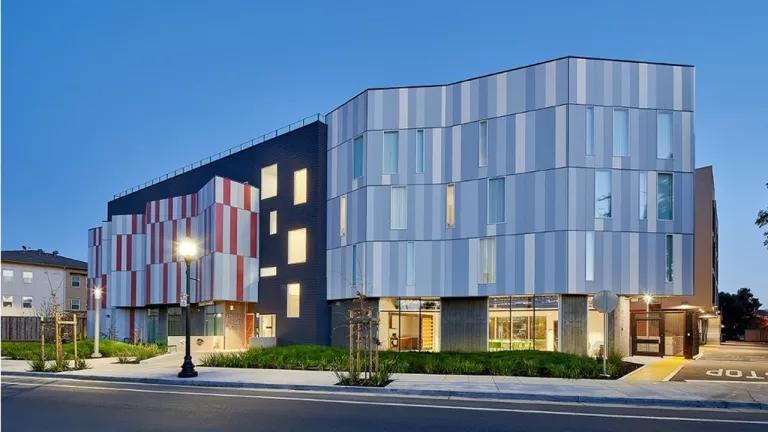The Pathway to New All-Electric Low Income Housing in CA
A key question for equity, health, and the environment is how to ensure that affordable housing providers are supported in building efficient, emissions-free all-electric homes.

MidPen's first all-electric affordable housing project with David Baker Architects: Edwina Benner Plaza in Sunnyvale, California.
This blog was co-authored by Srinidhi Sampath Kumar (California Housing Partnership)
The winds of change are blowing in California—toward all-electric new buildings powered by an increasingly clean electric grid. A key question for equity, health, and the environment is how to ensure that affordable housing providers in California—which serve thousands of low-income families—are supported in building efficient, emissions-free all-electric homes.
Already 30 local governments in California have passed building codes that encourage or require all-electric new buildings. The California Public Utilities Commission has also opened a Building Decarbonization proceeding that addresses, among other things, Senate Bill 1477’s Building Initiative for Low Emissions Development (BUILD) program. BUILD targets decarbonizing new residential construction, with a significant portion of the funding ($60 million) dedicated to low income housing, and will be administered by the California Energy Commission (CEC).
Supporting new affordable housing can and should be a top priority for the state. Even prior to the COVID-19 pandemic, 1.3 million low-income households lacked access to affordable homes. Further, the cost of constructing one affordable housing unit in California is the highest in the country with the cost per square foot reaching $700 in 2019, a 30 percent increase from 2016. A report by the Terner Center for Housing Innovation highlights the need for flexibility in building design requirements and alternative ways to lower costs as “every dollar saved translates into subsidy for additional units.” Supporting the development of efficient, all-electric affordable housing can reduce costs, improve community and resident health, and further our climate goals.
Moving from gas to electricity is fundamental to community health and climate progress
California buildings are responsible for about 25 percent of statewide greenhouse gas (GHG) emissions. To curb them, the state has adopted aggressive GHG emission reduction targets, including returning to 1990 levels by 2020, 40 percent below the 1990 levels by 2030, and full carbon neutrality by 2045. Moving from fossil gas to electricity for space and water heating in buildings will be key to reaching these goals, and is doable given the availability of efficient electric appliances and California’s widespread access to electricity generated from renewable resources like wind and solar energy.
Buildings in California burn more gas and emit about seven times more nitrogen oxide (NOx) pollution than all of the state’s power plants. NOx pollution can lead to respiratory problems, from coughing and wheezing to decreased lung function, and can contribute to hospitalizations and even premature death. Therefore, there will be substantial public health benefits from supporting the transition to all-electric buildings.
Affordable housing developers are already leading the way, but need support
Several affordable housing developers have completed all-electric projects and have more in the pipeline, while many others are considering all-electric construction as momentum builds. For example, the Fresno Housing Authority, motivated by local air quality concerns and cost savings, has been developing all-electric buildings since 2015, with nine projects either built or in the pipeline.
Wakeland Housing and Development Corporation, with projects in San Diego, Los Angeles and Riverside counties, has one new development under construction and has completed one all-electric retrofit of an existing building. They intend to have most of their future projects be all-electric due to environmental concerns. They also value the time saved in only connecting one utility service.
During a recent listening session with four affordable housing developers, participants acknowledged that they see the market moving toward all-electric construction, but said new policies could better support this transition. Many of our policy recommendations are informed by feedback from these and other affordable housing developers.
Here are six policy actions that will ensure a smooth transition to all-electric new affordable housing in California:
1. Accelerate the evolution of the Title 24 building code toward decarbonization
While much progress has been made to remove hurdles to electrification in the 2019 update to the state’s building energy code, referred to as Title 24, those changes focused largely on single-family and low-rise residential homes. Much remains to be done for affordable housing, which tends to be multifamily buildings that often have “central” hot water (one system that serves the whole building). The California Energy Commission (CEC) and the Statewide Codes and Standards Program are currently pursuing major enhancements to the energy code compliance software to enable new construction and retrofits with highly-efficient electric central heat pump water heater (CHPWH) systems to be modeled in order to meet the code, but these critical enhancements are not yet available. These changes are essential and a high priority to support developers.
Additional Title 24 changes to support affordable housing providers must also include: 1) Better valuing high-efficiency variable refrigerant flow (VRF), variable capacity heat pumps (VCHP), and inverter-driven package-terminal heat pumps (PTHP) to make it easier to build or retrofit existing buildings with high-efficiency electric equipment; 2) Providing building code compliance credit for solar photovoltaic (PV) and battery storage for all-electric mid- and high-rise buildings (currently only available for single-family and low-rise buildings), to facilitate electrification of space and water heating systems; and 3) Supporting a broader range of CHPWH designs, including “multi-pass” systems, as well as systems without a separate recirculation heater, to provide more cost-effective options for developers.
2. Provide robust and flexible technical assistance to housing developers
Affordable housing providers are often constrained by staff capacity, short deadlines for project completion to meet their funding application, and limited funding. Housing providers also have varied expertise around sustainability and electrification. However, even for the most savvy affordable housing providers in California, all-electric construction is new. Direct technical support for developers’ first few all-electric projects will confer the experience and confidence needed to make the switch.
We recommend that the BUILD program provide a technical assistance “budget” to each affordable housing developer that applies to the program and that developers can choose the type of assistance they require based on their needs and internal capability. Similarly, local Community Choice Aggregators (CCA) and other utilities can offer technical assistance to affordable housing providers that are interested in going all-electric. Based on several housing providers’ experience developing all-electric new construction, technical support that has been useful and should be considered for BUILD and other programs includes:
- Expertise navigating different requirements, including those of Title 24, TCAC housing tax credits, Green Point rating, and solar procurement, as well as closely coordinating with the local jurisdiction, the CEC, and the building’s design team to ensure a smooth process;
- Working with the design team to set expectations, choose equipment, size the systems, identify vendors, and work on pricing;
- Assessing the performance of the installed systems to ensure they are operating optimally prior to resident occupancy, especially as electric hot water systems can be complex and many local engineers and contractors working with the affordable housing community may have little to no experience working with these systems; and
- Managing and using data from different sources including from the utilities, accounting software, solar inverters, EV charging stations, smart thermostats and the ENERGY STAR Portfolio software to create a feedback loop to inform housing provider decisions, and to share critical information to agencies like the CEC and identify further opportunities for reducing building emissions.
3. Offer technical training for the designers, engineers, and contractors working on affordable housing
A growing but still relatively small number of California-based designers, engineers, and contractors have experience in all-electric construction. Many engineers and contractors have established cookie-cutter guidelines to build quickly using gas systems, but such in-house guidelines are less common for the newer electric systems. Further, even with some affordable housing providers interested in going all-electric, engineers express concern that the new technologies will cause project timeline extensions as they get up to speed on designing, engineering and sizing the systems appropriately, which could cause the affordable housing providers to face penalties for not meeting deadlines. Contractors who are unfamiliar with the technology may charge more, and designers may not be accustomed to planning electrical panel spacing in a way that supports space and water heaters. Training through utilities, community choice aggregators, or the CEC should be offered to designers, engineers and contractors to improve their familiarity with new technologies and reduce the risk of extended timelines or increased costs.
4. Support electrification in existing affordable housing programs
There are a number of sources of funding for affordable housing in California, including the Tax Credit Allocation Committee (TCAC), the California Debt Limit Allocation Committee (CDLAC), and the Affordable Housing and Sustainable Communities (AHSC) program. These funding sources should support the state's climate and air quality goals. These programs should recognize the value of electrification and provide additional points in the selection process for electrification measures. In addition, TCAC should revise its “threshold basis limit increases,” which puts restrictions on the total cost of a project, as they relate to renewables and electrification measures, to accommodate the additional upfront costs (and benefits) of these measures.
5. Work closely with affordable housing developers in designing local building codes
Cities and counties are leading the way by passing building codes that encourage or require all-electric new buildings. It is vital that local governments work closely with affordable housing providers to make sure these codes do not create barriers to new housing. Affordable housing providers have reported needing to redesign projects that are already far along in the development process, at significant cost, in order to comply with local codes. An easy solution to this problem is to gradually phase in new all-electric requirements, giving developers sufficient time to plan ahead, rather than rushing implementation timelines and forcing costly late-stage changes to project designs. Some local codes may also be overly burdensome for low-income projects if there is not additional funding to support the work required. For example, where local “reach” codes that go beyond the state’s minimum code also require electric vehicle charging, some developers report having to choose between electrifying in-unit appliances and installing electric vehicle charging stations, due to budget constraints. One developer reported that this high cost is attributable to the need to add additional electrical infrastructure to accommodate the significant new loads of building electrification and EV charging stations.
6. Utilities should support new all-electric projects by funding electric system and service upgrades and by speeding new electric connections
Affordable housing is extremely cost-constrained and must be delivered on a tight schedule to qualify for state and federal funding. Utilities can support all-electric affordable housing by funding grid or service upgrades needed due to the building’s electric demand. Utilities should also fast track the review, approvals, and service connections for all-electric projects to avoid delays that can affect project funding.
These policy recommendations require very limited public funding, but will boost the affordable housing community’s transition to all-electric buildings and should be implemented as soon as possible to reap the health, environment, and cost benefits that all-electric housing can provide.




